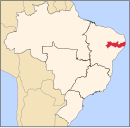Camaragibe
Camaragibe | |
|---|---|
| Municipality of Camaragibe Município de Camaragibe | |
| Motto(s): Fé e Esperança "Faith and Hope" | |
 Location in the state of Pernambuco and Brazil | |
| Coordinates: 8°01′19″S 34°58′51″W / 8.02194°S 34.98083°W | |
| Country | |
| Region | Northeast |
| State | Pernambuco |
| Founded | 13 March 1982[1] |
| Named for | Lantana camara (plant)[2] |
| Government | |
| • Type | Mayor–council government |
| • Mayor | Nadegi Queiroz, 2021– 2024 (Republicanos) |
| Area | |
• Total | 51.321 km2 (19.815 sq mi) |
| Elevation | 55 m (180 ft) |
| Population (2022)[4] | |
• Total | 147,771 |
• Estimate (2024) | 155,771 |
| • Density | 2,900/km2 (7,500/sq mi) |
| Time zone | UTC−3 (Brasília Time) |
| Area code | +55 81 |
| Website | www |
Camaragibe is a city in the Northeast region of Brazil, in the state of Pernambuco. It lies within the Greater Recife — Brazil's 5th-largest metropolitan area.[5]
Currently, Camaragibe is run by Nadegi Queiroz (from the political party Republicanos) and Délio Junior (The Vice-mayor).
The lands now belonging to the city were used as a reserve of wood, and then for sugar planting. It was populated by natives, until the arrival of Portuguese with Duarte Coelho Pereira, around 1500. After the Portuguese arrival, however, the natives were not completely driven from the area.
In the 16th century, the city (then just an engenho) was considered one of the richest in the region until the Dutch invasion in 1645. At that time, the farm was burned to the ground by the natives.
On 13 May 1982, Camaragibe, which was then part of the bigger city São Lourenço da Mata, was elevated to the category of city.
The small city is considered among the most densely populated urban areas in the world because of the very accelerated growth that the city experienced from the emancipation until now.
Geography
- State - Pernambuco
- Region - RMR (Recife)
- Boundaries - Paulista (N), Sao Lourenco da Mata (S), Paudalho (W), Recife (E)
- Area - 55.08 km2
- Elevation - 55 m
- Hydrography - Capibaribe and Beberibe rivers
- Vegetation - Hidrofila, capoeira, and sugarcane plantation
- Climate - Hot tropical and humid
- Annual average temperature - 25.1 °C
- Main road - PE 005
- Distance to Recife - 16 km
Economy
The main economic activities in Camaragibe are based in commerce and general industry. Also is a main and terminal stop in the metropolitan train (subway or tube system), with integration with local bus lanes.
Economic Indicators
| Population [6] | GDP x(1000 R$).[7] | GDP pc (R$) | PE | RMR |
|---|---|---|---|---|
| 143.210 | 492.113 | 3.608 | 0.82% | 1.22% |
Economy by Sector 2006
| Primary sector | Secondary sector | Service sector |
|---|---|---|
| 1.43% | 13.35% | 85.22% |
Health Indicators
| HDI (2000) | Hospitals (2007) | Hospitals beds (2007) | Children's Mortality every 1000 (2005) |
|---|---|---|---|
| 0.747 | 4 | 1291 | 15.1 |
Notable people
- Hélio José Muniz Filho, Brazilian criminal suspected of killing 65 people
- Érica de Sena, racewalker
See also
References
- ^ "Camaragibe Municipality Official Website" (in Portuguese). Retrieved 2 September 2024.
- ^ "Municipality of Camaragibe Official Website" (in Portuguese). Retrieved 3 September 2024.
- ^ "Brazilian Institute of Geography and Statistics" (in Portuguese). 2022. Retrieved 3 September 2024.
2022 Area Total
- ^ IBGE 2022
- ^ "Censo do IBGE: população do Recife encolhe 3,17% desde 2010". G1 (in Brazilian Portuguese). 2023-06-28. Retrieved 2024-09-04.
- ^ http://www.ibge.gov.br/home/estatistica/populacao/estimativa2009/POP2009_DOU.pdf IBGE Population 2009 Camaragibe, page 32]
- ^ Camaragibe 2007 GDP IBGE pag 30 Archived March 4, 2016, at the Wayback Machine
- ^ PE State site - City by city profile





